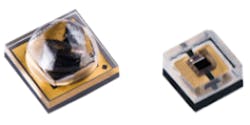Compact ultraviolet LEDs will enable novel approaches to sterilization and disinfection applications, and the potential of that market has led Luminus Devices to add shorter-wavelength UV-C devices to its portfolio.
Interested in articles & announcements on UV LEDs in life science applications?
We’ve been charting the progress of UV-C LEDs for several years. The UV-C LED technology — in terms of cost, radiometric power output, efficiency, reliability, and lifetime — has trailed the longer-wavelength UV-B and UV-A LEDs that are primarily used in industrial applications such as curing. We covered the basics of the UV bands in an article about presentations at Strategies in Light a few years back.
Still, we have seen steady improvement in performance in the past few years. For example, Crystal IS announced products earlier this year that it said offer the power output/cost ratio that would lead to high-volume commercialization. Those products deliver in the range of 30–40 mW of radiometric power.
The Luminus UV LEDs that were just announced span a broad gap in terms of emitter size and power output. As the model numbers imply, the smaller device measures 1.3×1.3 mm in footprint while the larger measures 3.5×3.5 mm. The smaller LED delivers 11 mW of peak output driven at 100 mA and the larger LED delivers peak output of 60 mW at 350 mA.
Those performance levels could certainly enable many developments in disinfection, although other factors such as cost and reliability are factors as well. Moreover, the two different emitter sizes offered by Luminus could serve in vastly different form factors. Both LEDs are based on surface-mount technology (SMT) and the smaller device stands just 0.85 mm tall.
Luminus clearly sees the market as ready to expand. “Air, surface, and water disinfection markets will see a significant number of new products and new product categories over the next 36 months,” said Stephane Bellosguardo, vice president of specialty lighting marketing at Luminus. “Just as the computer industry was driven by ever smaller and faster processors, so will be the innovation in markets like air and water purification with miniature products like our 1313 UV-C LED.”
The new UV-C LEDs join an existing portfolio of UV-A LEDs from Luminus offered both in SMT packages and in small modules based on metal-core printed-circuit boards (MCPCBs). The company has previously targeted curing, 3D printing, endoscopy, horticultural, and other applications for UV.
Also, we would add a note about UV-C applications relative to LED lifetime and cost. Generally, there has been concern in the industry that UV-C LED lifetimes need improvement to deliver on the promise of the solid-state lighting (SSL) approach to the sterilization sector. But we just published a feature article that does a great job of explaining that LED-based products will inherently deliver a different usage model and scenario relative to products based on legacy UV sources. In fact, UV-C LEDs may well already outlast legacy sources in many applications, and even at a higher upfront cost deliver superior return on investment.







